La Lengua Inglesa
para estudiantes de 4.o grado
En 4.o grado, los estudiantes se enfocarán principalmente en el uso de textos para aprender sobre el mundo. Los maestros aún apoyan la fluidez en la lectura de los estudiantes, pero los estudiantes pasarán la mayor parte del tiempo leyendo, escribiendo y hablando sobre textos con diferentes complejidades. Los textos deben ser mitad ficción y mitad no ficción. Los textos deben representar personas, ideas e identidades diversas, incluyendo la voz y la perspectiva de las personas Dakota y Anishinaabe, tanto históricas como contemporáneas. Los estudiantes de 4.o grado también deben escribir con frecuencia. Trabajarán en la redacción de una tarea durante un período de clase y en el transcurso de varios días. Practicarán la investigación, la reflexión y la revisión.
Para ver todos los estándares estatales de 4.o grado para ELA vea aquí: education.mn.gov/mde/dse/stds/ela
Tip (NEEDS TRANSLATING): Hover over icons to see definitions of key terms.
This is an example tooltip! (NEEDS TRANSLATING)

A fin de año, los estudiantes de 4.o grado deben entender y poder hacer bien lo siguiente:
HABILIDADES DE LECTURA Y ESCRITURA
Escribir oraciones y párrafos completos, mayormente con el uso correcto de la ortografía, mayúsculas y puntuación, incluyendo comas, apóstrofos, comillas y puntuación al final de la oración1
Overall, dogs are awesome pets to have.
Have I convinced you though? If you are, then great!
If you’re not then that’s okay. It’s really up to you.
So which one is it going to be?
Leer y comprender diversos tipos de textos de 4.o grado (nivel Lexile® 740-1010) sin problemas y con expresión a una velocidad de fluidez de aproximadamente 90 a 140 palabras por minuto.
Usar tecnología (con cierto apoyo si es necesario) para producir y publicar escritos, así como trabajar con otros.
Escribir una página como mínimo en un solo período de clase.
APRENDER SOBRE EL MUNDO A TRAVÉS DEL TEXTO
Hacer y responder preguntas sobre textos leídos por su cuenta. Usar evidencia específica del texto para explicar eventos y procedimientos, explicar la idea principal, conectar ideas y fundamentar las deducciones sobre el texto1
The book Charlotte’s Web by E. B. White is a story about an endearing pig named Wilbur. He is desperately trying not to die. He meets a nice friend named Charlotte. She is a spider that weaves words into her web to save Wilbur from dying. Charlotte was one of the most caring friends you could have for a long time. One way she was caring was when Wilbur was tired of being terrific all day. Charlotte sang him a lullaby. Another example is that she calmed Wilbur down when he was scared. Wilbur was devastated when he found out he was going to die and Charlotte said, “You shall not die I shall save you.”
Deducir el significado de palabras desconocidas valiéndose de imágenes, contexto, glosarios, etcétera. Deducir palabras con múltiples significados o lenguaje figurativo
THE SKY IS LOW BY EMILY DICKINSON
The sky is low, the clouds are mean,
A travelling flake of snow
Across a barn or through a rut
Debates if it will go.
A narrow wind complains all day
How someone treated him;
Nature, like us, is sometimes caught
Without her diadem.
Usar conectores para vincular opiniones y motivos. Por ejemplo, usar “con el fin de”, “por ejemplo”, etcétera
Usar frases de transición para mostrar el orden de los eventos. Por ejemplo, usar “primero”, “además”, etcétera
- Escribir sobre lo que sucedió o la información que obtuvieron del texto. Incluir un título, una
introducción, ejemplos bien desarrollados, vocabulario relacionado con el tema y una conclusión
Escribir historias creativas sobre experiencias reales o imaginarias. Los estudiantes deben presentar a un narrador o los personajes y organizar eventos en un orden natural. Las historias deben incluir conversaciones, descripciones de personajes, detalles sensoriales y una conclusión1
FINDING ROSALITA
It was Sunday. My family and I were in France. I was
as happy as a bee. We were driving along the road
when my daddy stopped the car. He told my brother
and sister to get out of the car to see what the furry
lump on the side of the road was. They got out of the
car. Ten seconds later, they got back in the car with
a very small kitten in their hands. She was about the
size of a very, very, very, very small baby bottle.
My stomach went into my throat when I saw it actually
was a kitten. She was meowing as loud as a foghorn. It
was so horrible, I couldn’t think. Mreow. I felt horrible.
I knew that I hadn’t done anything bad to her, but I just
couldn’t help it. She was so cold. I was worried. Her
claws were as sharp as sewing needles being pricked
into your skin. I shuddered. She had crusts over her
eyes, from infections, that looked like they hurt.
We were headed into the village. Madame Sanz
was there. We asked her what to do. I was afraid
that she wouldn’t have any advice. Thankfully, she
told us what to do. She told us to boil rose petals
in water till they were warm and wet. Then we
should pour them into a bowl with some water and
keep on rubbing then over the kitten’s eyes.
After that, we decided to call the little kitten
Rosalita. We also call her other things that sound
like Rosalita, but I won’t mention that. We prayed.
Luckily, she is still with us now. Hopefully, she
will be with us much, much, much, much longer.
1Muestra de escritura reproducida con permiso de Student Partners. “Student Writing Samples.” Achieve the Core, https://achievethecore.org/category/330/student-writing-samples
EJEMPLOS DE ELA DE 4.O GRADO
Sidebar Tooltip
“The Seedling” By Paul Laurence Dunbar
1
As a quiet little seedling
Lay within its darksome bed,
To itself it fell a-talking,
And this is what it said:
5
“I am not so very robust,
But I’ll do the best I can;”
And the seedling from that moment
Its work of life began.
So it pushed a little leaflet
Up into the light of day,
10
To examine the surroundings
And show the rest the way.
The leaflet liked the prospect,
So it called its brother, Stem;
15
Then two other leaflets heard it,
And quickly followed them.
To be sure, the haste & hurry
Made the seedling sweat & pant;
But almost before it knew it
20
It found itself a plant.
The sunshine poured upon it,
And the clouds they gave a shower;
And the little plant kept growing
Till it found itself a flower.
25
Little folks, be like the seedling,
Always do the best you can;
Every child must share life’s labor
Just as well as every man.
And the sun & showers will help you
30
Through the lonesome, struggling hours,
Till you raise to light & beauty
Virtue’s fair, unfading flowers
Example Tooltip
PREGUNTAS DE COMPRENSIÓN
¿Qué significa la palabra en inglés “robust” (robusto) tal como se usa en la línea 5 de “The Seeding”?
¿Por qué la palabra en inglés “robust” (robusto) es importante en el poema?
¿Qué es importante acerca de las dos últimas estrofas (líneas 25-32) en “The Seedling”?
Parte A: En el poema 1, “The Seeding”, ¿qué tema desarrolla el autor a lo largo del poema?
- La primavera es la mejor época del año.
- Es importante hacer las cosas por cuenta propia.
- El sol y las nubes son partes importantes de la naturaleza.
- El apoyo de los demás puede ayudarte a lograr grandes cosas.
Part B: Parte B: ¿Qué líneas de “The Seedling” ayudan a respaldar la respuesta correcta de la parte A?
- “And the seedling from that moment/ Its work of life began.” (líneas 7-8)
- “To be sure, the haste & hurry/Made the seedling sweat & pant;” (líneas 17-18)
- “The sunshine poured upon it/And the clouds they gave a shower” (líneas 21-22)
- “Till you raise to light & beauty/Virtue’s fair, unfading flowers” (líneas 31-32)
Introduces main characters
Uses a variety of transition words &
phrases to manage the sequence of events
Establishes a situation
Uses end of sentence punctuation accurately
Uses concrete words & phrases & sensory details to convey events correctly
The Haunted House
There once was a dog who roamed an alley with another dog. That dog’s name was Max. The other dog’s name was Rocky. Max & Rockey were brother & sister, although the look nothing alike . In another alley not far from Max & Rocky’s there was a dog & a cat who lived together in that alley. The dog’s name was Surgar & the cat’s name was shantell. One day they all met behind a trachcan & became best buds.
One day while all the friends were out walking in the street & then Shantell(thecat) spotted a ghost flying around in a house & took off running to go see the ghost. Then all the dogs took off afterer her. When the dogs finaly cought up
to Shantell they
were all deep in the huanted house. Max & Surgar started to shake. Rocky & Shantell started to quake. Then a loud Boom came from the floor above them. After, Max got a brillent idea. They should sneak up on the monsters & attack them
.
Finally all four animals were ready to put their maniecle plan into action. Shantell tip-toed up the mantel while Max & Surgar went up the back stairs. Which left Rockey creeping up the front stairs. When they all were ready to attack the monsters they heard music. The went alot like this “Shake, Shake shake dem bones now!” The friends were confused but quickly got back on track. Shantell gave the ready signal & they all jumped up.
They were surprized to see what they saw. They saw about a dozen monsters doing the monster mash. One of the vampires said “Come in dogs & cats. Why don’t you dance with us. So Max, Rocky, Surgar & Shantell danced with the monsters.”
Example Tooltip
ACTIVIDADES DIARIAS PARA RESPALDAR EL APRENDIZAJE
Tips for Talking to Teachers
A strong relationship between families and teachers is key to ensuring students have what they need to succeed. Parent involvement not only leads to higher grades and test scores, but also helps students develop self-confidence, motivation, and social skills. Knowing what questions to ask at school visits and parent-teacher conferences can help you feel confident when it comes to addressing your child’s’ academic needs.

